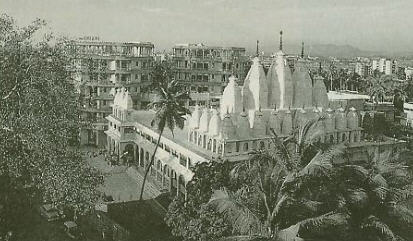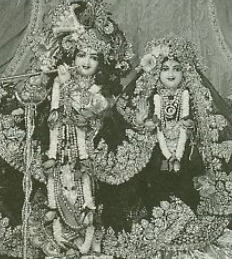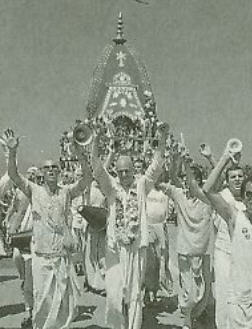A look at the past, present, and future of the Hare Krsna Movement.
Reprinted from India West Magazine, July 3, 1992.
IN 1965, AN ELDERLY swami arrived in New York aboard the Jaladuta, a freighter of the Scindia Steamship Company. His only possessions were his saffron robes, forty rupees, his translations of Srimad-Bhagavatam (the Bhagavata Purana), and unflinching devotion to Lord Krsna. The sadhu's name was A.C. Bhaktivedanta Swami Prabhupada.
A year later, Srila Prabhupada, as his disciples fondly called him, founded the International Society for Krishna Consciousness (ISKCON) at a small storefront center in New York City. Over the next twenty-five years, ISKCON grew into a world network of more than three hundred temples, asramas, schools, institutes, and farm communities, serving the spiritual needs of people around the world.
This year ISKCON celebrates its twenty-fifth anniversary and looks forward to 1996, the hundredth anniversary of Prabhupada's birth.
Mission
Srila Prabhupada was born on September 1, 1896, in Calcutta, the son of Gour Mohan De, a cloth merchant. Prabhupada was raised a strict Vaisnava. He later graduated from Scottish Churches College, but as a follower of Gandhi he refused his degree. One of his classmates was Subhash Chandra Bose.
In 1922, at age twenty-six, Srila Prabhupada met his spiritual master, Srila Bhaktisiddhanta Sarasvati, a Vaisnava acarya in the line from Sri Caitanya Mahaprabhu.
Caitanya Mahaprabhu, who spread the movement of bhakti, or devotion, appeared at Mayapur, West Bengal, in 1486. During the forty-eight years of His presence, Caitanya Mahaprabhu spread the congregational chanting of the holy names of the Lord (Hare Krsna, Hare Rama) all over the Indian subcontinent. He predicted that the same chanting would spread to every town and village in the world.
Bhaktisiddhanta Sarasvati, eager to see the prophecy fulfilled, asked Prabhupada to spread the teachings of Caitanya Mahaprabhu and Lord Krsna to the Western world.
In 1944, Prabhupada started a fortnightly English paper called Back to Godhead. In 1954, he retired from family life, and in 1959 formally accepted sannyasa, the renounced order. Taking up residence in the holy town of Vrndavana, where Lord Krsna had appeared several thousand years before, Prabhupada began translating the Srimad-Bhagavatam.
In 1965, with the first three volumes printed, he departed alone for the United States.
Growth of ISKCON
At first Srila Prabhupada found his warmest welcome among young educated Americans dissatisfied with what they saw as a materialistic culture. Many gave up promising careers to join the fledgling Hare Krsna movement.

ISKCON Juhu Temple
After a few years, in which ISKCON spread rapidly throughout North America and Europe, Prabhupada returned to India. There he began large temple projects in Bombay, Vrndavana, and Mayapur (West Bengal). During this time, many leading citizens of India became life members of ISKCON. And many Indian young people also became Srila Prabhupada's disciples.
Of course, all was not sweetness and light. Some caste-conscious people thought that Prabhupada was violating Vedic rules by initiating non-Hindus as brahmanas. To such critics, Prabhupada responded by giving much evidence that people from any part of the world can become Vaisnavas and brahmanas if they come to the proper standard of behavior.
Still other critics debated ISKCON's commitment to Hinduism. In this regard, Srila Prabhupada emphasized the universality of the Hindu or Vedic teachings, with their message of love for God as the highest goal of life. He did not take a narrow sectarian view. He often said that one should be ready to recognize love of God wherever it was displayed be it among Hindus, Christians, Muslims, or Jews.
Meanwhile, back in America, Europe, and other parts of the world, members of the Indian community began to visit the ISKCON temples in growing numbers.
In the early 1970s, when ISKCON was in the midst of its initial expansion, there were few Hindu temples in North American other than those of ISKCON. So there was nowhere else Indian immigrants of Vaisnava background could see the Deities (murtis) of Lord Krsna being worshiped.
"When I came to this country as a young student, I felt all alone," says C. Patel of Chicago, now a successful businessman. "Then I found the Hare Krsna temple. I felt so much at home there. The devotees were so kind to me and everyone else who came. I experienced much satisfaction seeing Lord Krsna being so nicely worshiped. I vowed that someday, if I ever became successful, I would repay them.
"Years later I went to the temple and asked them what was the balance on their mortgage. When they told me, I wrote a check for the entire amount. I felt it was the least I could do. Not only was I paying back my own personal debt I was also ensuring that the experiences that meant so much to me would continue to be available to others."

Sri Sri Radha-Giridhari at ISKCON San Diego
The encounter between Indians and Westerners in ISKCON temples was not without some rough spots. Some of the Western disciples were a little suspicious of the Indian immigrants.
By coming to the West, hadn't those Indians given up their spiritual heritage to chase after the illusion of material progress?
But most Western disciples were happy to receive the Indian visitors, many of whom were lifelong Vaisnavas. The Indians conferred respectability upon the fledgling Hare Krsna movement, and their advice and contributions were welcome.
From the side of Indians, there were also mixed feelings. For one thing, ISKCON was a distinctly missionary movement. Prabhupada came to America not just to lecture among Indians but to introduce Vedic philosophy and culture to everyone. It was a revolutionary idea, a seemingly impossible task. But somehow he was succeeding.
Yet, as one might expect, the Hare Krsna movement encountered opposition. Some Western parents objected to their adult children taking up an alien religion and way of life. A few parents brought lawsuits against the movement. Other people objected to the aggressive presence of Hare Krsna members in public places. Millions of people purchased copies of Bhagavad-gita from the devotees, but other people were annoyed and turned off.
For many members of the Indian community, eager to get established in American society and not too eager to rock the boat, the negative press ISKCON sometimes received was troubling. To see young Westerners going vegetarian, giving up intoxicants, and taking to the discipline of bhakti-yoga was wonderful. But the notoriety of these enthusiastic young converts made many Indians uneasy.
After Prabhupada's Passing
Inevitably, the movement also had its internal ups and downs, especially in the first years after Prabhupada passed away, in 1977. Some successor gurus fell by the wayside. And New Vrindavana, the largest ISKCON community in North America, was expelled from ISKCON after its leaders were implicated in crimes and started blending Vaisnavism with Christianity. But as the years have passed, the Hare Krsna movement appears to have weathered these tests, and it continues to expand.
As Prabhupada envisioned, the administrative leadership of the movement has passed to a governing body of thirty members from around the world. And individual spiritual guidance is provided by a multiplicity of gurus, none of whom has a uniquely privileged status.
Continuing to Spread Vedic Culture
As ISKCON's leadership looks toward the next twenty years of growth, it hopes to build better relations with the Indian community.
Of course, the West now has many Indian cultural and religious groups to help preserve regional customs and traditions. And there are many Indian business, professional, and political groups to speak out on government policies that affect the Indian community.
But among these organizations, ISKCON believes it retains a certain uniqueness. It reaches beyond the Indian community to the world at large and has proven successful in getting non-Indians to adopt the undiluted values, teachings, and practices of the Vedic culture.
ISKCON is performing that duty in North America, South America, Europe, Asia, Africa, Australia, and the islands of the Pacific. As a result, people of all nationalities and races have given up bad habits and taken to bhakti-yoga, devotional service to Lord Krsna.
Under KGB oppression in the former Soviet Union, young men and women in ISKCON risked their lives to spread the teachings of Bhagavad-gita. Many of these people Russians, Ukrainians, Lithuanians, Armenians went to prisons and labor camps rather than give up their devotion to Lord Krsna.
Now that times have changed, ISKCON has established dozens of temples large and small in Russia and other former Soviet republics.
Yet even today, men and women of ISKCON are spreading the message of the Gita and Vedic culture in places that cannot be mentioned, for fear of endangering the devotees' lives. It is this willingness to sacrifice personal safety and comfort for the sake of other's spiritual welfare that guarantees ISKCON's second twenty-five years will be as inspiring and productive as the first.
Drutakarma Dasa is an Associate Editor of Back to Godhead. He lives in San Diego.
ISKCON and Its Accomplishments
ISKCON BELIEVES THAT PEOPLE everywhere need Vedic knowledge to break free from illusion and the suffering it brings.

Rathayatra in Los Angeles
To spread this knowledge, ISKCON's sister organization, the Bhaktivedanta Book Trust, has become the world's largest publisher of books on the Vedic teachings. It has sold more than 400 million books in over ninety languages.
ISKCON members, through Project Matsya, have toured India making microfilm copies of thousands of rare Vedic manuscripts that were in danger of being lost.
ISKCON's Bhaktivedanta Institute studies modern science in the light of Vedic knowledge and presents Vedic knowledge from a scientific point of view. The institute is now planning a Vedic Planetarium and Science Museum.
The 280 major ISKCON temples serve as cultural, religious, and educational centers for millions of Indians and others drawn to Vedic culture.
In ISKCON temples, beautiful Deities are worshiped with love and devotion. Full-time pujaris (priests) perform five to seven aratis and bhoga offerings daily. ISKCON temples provide darsana, puja, discourses, and samskaras (weddings, grain ceremonies, etc.), purifying the lives of millions of devotees and other interested souls.
ISKCON has set in place more than forty temples and cultural complexes in India, such as Hare Krishna Land at Juhu Beach in Bombay, the Krishna-Balaram temple in Vrndavana, and the Caitanya Chandrodaya Mandir in Mayapur, West Bengal. ISKCON has also been active in renovating temples and shrines at pilgrimage places all over India.
At ISKCON's forty-one farming communities around the world, devotees are giving loving care to cows, bulls, and calves.
More than 900 million plates of prasadam, spiritual vegetarian food, have been served through ISKCON's temples, festivals, restaurants, and food relief programs.
ISKCON has also celebrated more than five hundred Rathayatras in the world's major cities, including London, New York, Moscow, Sydney, and Bombay.
In a new development, supporters of ISKCON Indian and American have formed the ISKCON Foundation. Its chairman is Alfred Brush Ford (Ambarisa Dasa), a disciple of Srila Prabhupada and great-grandson of Henry Ford. Among the vice chairmen: Dr. Vibhakar J. Mody of Washington, D.C., Dr. Arvind Singh of Houston, Texas, and Mr. Dahyabhai Patel of Irvine, California.
The Foundation's purpose is to help ISKCON and its local communities work more effectively to achieve the many goals Srila Prabhupada set out.
"The ISKCON Foundation is a vehicle to carry Srila Prabhupada's movement into the next millennium," says Ford. "Only by offering people the genuine Vedic culture of India can we satisfy their desires for peace, prosperity, and spiritual fulfillment."
